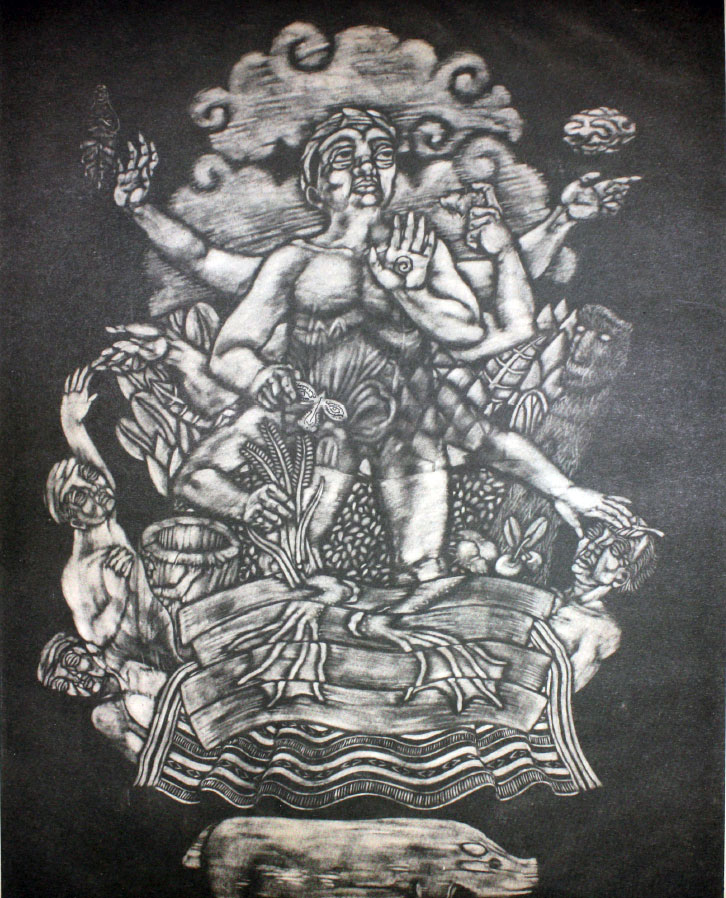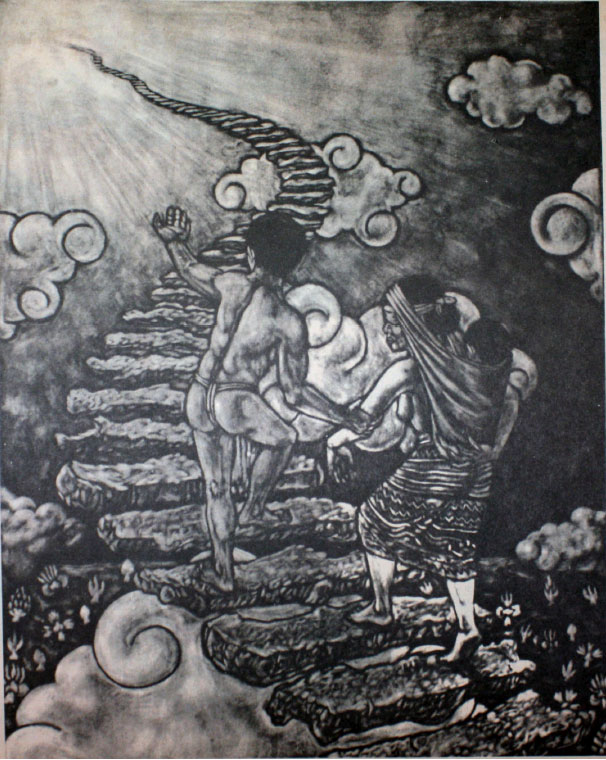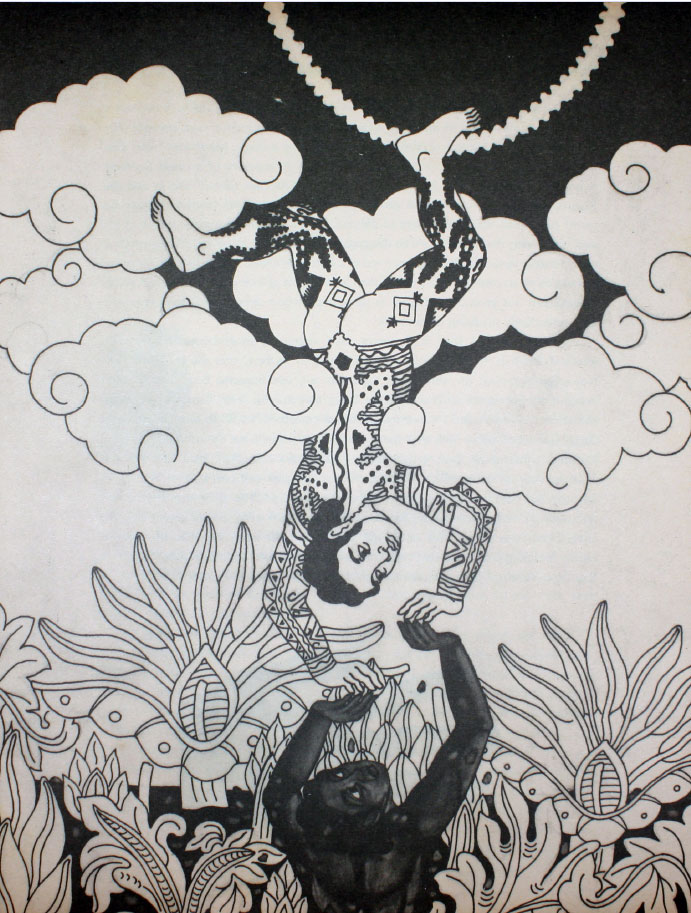Psychopomp is a word that is derived from Greek psukhe ‘soul’, pompe ‘procession’ and pempein ‘send’. In world mythologies they are described as guides for the souls of the dead, which are usually accompanied to some sort of afterlife.
Some Philippine deities which exhibit psychopomp aspects can be described in terms of the following archetypes:
Across the river
The most common psychopomp archetype that recurs in Philippine myth is the divinity that ferries souls across a body of water, usually a river, but sometimes the sea. This can be seen in Manduyapit, a Manobo divinity that is said to bring souls across a red river and Mama Guayen of Ilonggo lore, who also ferries souls to what is said to be the end of the world. Badadum, a Waray deity does not ferry souls across a river but gathers a recently deceased person’s family to meet the new soul along the mouth of a river.
The Sulod pantheon’s Bangla’e first judges the souls before he ferries them across the river the way the soul is carried depends on how the soul was in life, if they were good according to Bangla’e he would carry them on his shoulders, if they were deemed not desirable, they would have to be carried across the river while holding on to Bangla’e’s pubic hair.
The Priestess
There are also those psychopomps that help acclimate the soul into their new home. These psychopomps are usually female. In Bagobo belief Mebuyan is the chief priestess of a district of the underworld wherein the soul takes a ceremonial bath that makes them unwilling to return from the underworld. Mebuyan is also the name of a goddess of the underworld in Bagobo belief who takes care of the souls of dead infants, her body is covered with breasts which she uses to nurture those souls in the afterlife.

The Three Brothers of the Underworld
Another theme to note in Philippine myth, mostly from the Bisayas region is a trio of psychopomps. This trio is comprised of brothers who live in the underworld or a variation thereof and are responsible for guiding the soul, in the Sulod case for that soul’s entire life.
This can be seen in the Sulod trio of Mangganghaw, Manglaegas and Patag’aes. They have a relationship wherein each brother is in charge of a particular time in the soul’s lifetime, Mangganghaw watches before the soul is born and as it is conceived, Manglaegas makes sure that the child is born alive and Patag’aes holds a conversation with the soul of the newborn on how they want to live and die. While the three brothers in Sulod myth do not follow the traditional method of psychopomps i.e. guiding the soul after it dies, their duties in guiding the soul through life and eventually when they die (In the case of Patag’ aes) is enough to classify them as psychopomps.
In Bisaya mythology the psychopomp brothers’ methods are similar to those of the ferrymen in other Philippine groups. Magyan carries the souls of the dead to the underworld, called Kasakitan, in a boat called the balanday where there soul is taken by his brother Sumpoy to a subsection of the underworld called Kanitu-nituhan. Both these brothers live in the underworld while the third brother lives in the middleworld called Kamaritaan. While Makaptan does not guide the soul as he is a god of sickness, he is the husband of the goddess of death, Sidapa.

| Name of Psychopomp gods/ spirits | Ethnolingustic group / Area found |
| Bangla’e | Sulod |
| Mangganghaw | Sulod |
| Manglaegas | Sulod |
| Patag’aes | Sulod |
| Mama Guayen | Ilonggo |
| Magyan | Bisaya |
| Sumpoy | Bisaya |
| Manduyapit | Manobo |
| Andalapit | Bukidnon |
| Badadum | Waray |
| Imbayan / Lingayan | Ifugao |
| Munkal | Tausug |
| Nakir | Tausug |
Mangganghaw, Manglaegas and Patag’aes – This soul is watched over by three brother gods Mangganghaw, Manglaegas and Patag’aes. Mangganghaw keeps track over man’s affairs immediately after marriage. He keeps track of pregnancy. He is also the first to come to the house of a laboring mother, peeps in the house and sees the child being born, after which he reports to Manglaegas. Manglaegas, after being reported to by Mangganghaw, enters the house to look for the child to make sure the child was born alive, then reports to Patag’aes who waits until midnight then enters the house to have a conversation with the infant. If Patag’aes discovers anyone eavesdropping on their conversation, he chokes the child to death. The conversation is on how long the child wants to live and how the child will eventually die. The child gets to choose. After the child has chosen, Patag’aes takes out his measuring stick and computes the child’s life span, and then he departs.
Bangla’e – In Lim’awaen, a deep lake the deceased must face Bangla’e who ferries the souls across Lim’awaen. Bangla’e asks the soul how many spouses it had on earth. The soul cannot lie as the tuma, or body louse, an incarnation of the soul’s conscience is summoned. If the soul is male it is praised if it answers it had more than one wife, the soul is ridiculed if it answers ‘only one’ and if the soul did not have a wife at all it is made to swim in sticky black waters while hanging on to Bangla’e’s pubic hair. If the soul is female it is ridiculed if it had more than one husband.
Mama Guayen – a god that carries the souls of dead Ilonggos in a boat to the ends of the earth.
Magyan and Sumpoy – The deities of Kasakitan (The Bisaya underworld) are ruled over by the god Magyan, who carries the souls of the dead to Kasakitan on his boat called balanday. He is the brother of Makaptan and has another brother, Sumpoy. Sumpoy takes souls from Magyan’s balanday and carries them to a place in Kasakitan called kanitu-nituhan.
Manduyapit – the god who ferries departed souls across the red river before going to the afterworld.
Andalapit – god concerned with the souls of the Bukidnon.
Badadum – a guide of the dead, who gathers the souls of the newly dead to meet their relatives at the mouth of a river in the lower world.
Imbayan / Lingayan – spirits that guide souls after they die.
Munkal and Nakir – Angels that the faith of a newly deceased person. When the angel approaches the dead awaken and takes a listening position on one arm. Questions the dead with the basic tenets of the Islamic faith “Who is your god? Your prophet? In what direction should you pray?” etc. If the dead answers correctly it will continue to sleep until the day of judgment. If the dead answers wrong they are tortured in their tomb and eventually, Hell. Munkal stands on the right side of the dead while Nakir stands on the left.
Sources:
The Myths of the Philippines by Karl Gaverza (Undergraduate Thesis). 2014.
Philippine Mythology by Jocano. 1969.
The Soul Book by Demetrio and Cordero-Fernando. 1991.
ALSO READ: ENGKANTO & ANITOS: Could Science Be Close To Proving They’re Real?
Speculative fiction writer. Philippine folklore and heritage researcher.
Author of The Spirits of the Philippine Archipelago.
Currently in the middle of fixing up an encyclopedia of Philippine Mythical creatures.



